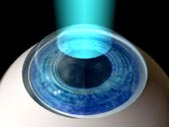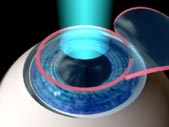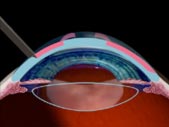Laser Vision Correction Today, almost all vision correction procedures are done with an excimer laser. The doctors at Bagan Strinden Vision use the most current technology, a VISX S4 laser with tracking and CustomVue. The excimer laser uses a cool, gentle beam of energy to remove minute amounts of tissue from the cornea, to change its shape to focus your eye better.
 These procedures are very effective and relatively simple ways to correct vision with the laser. The treatment is applied directly to the surface of the cornea, creating a new shape that is specific for your focusing. The advantage of these surface procedures is their simplicity: there is no flap, so there are few precautions in the days and weeks following the procedure. But the disadvantage of surface treatment is that it takes longer to recover excellent vision. The surface has to heal, so the vision clears gradually as the surface heals.
These procedures are very effective and relatively simple ways to correct vision with the laser. The treatment is applied directly to the surface of the cornea, creating a new shape that is specific for your focusing. The advantage of these surface procedures is their simplicity: there is no flap, so there are few precautions in the days and weeks following the procedure. But the disadvantage of surface treatment is that it takes longer to recover excellent vision. The surface has to heal, so the vision clears gradually as the surface heals.
 This is the excimer laser procedure developed to avoid some of the discomfort and slower recovery of vision of the PRK procedure. The PRK procedure reshapes the surface of the cornea, whereas in LASIK, the laser reshaping is done within the cornea. This is done by creating a thin, partial-thickness layer of cornea, with an instrument called a microkeratome. This layer, or flap as it is called, is then moved out of the way while the laser treatment is performed. The flap is then put back in its original position, where it assumes the new curvature of the remodeled cornea beneath it.
This is the excimer laser procedure developed to avoid some of the discomfort and slower recovery of vision of the PRK procedure. The PRK procedure reshapes the surface of the cornea, whereas in LASIK, the laser reshaping is done within the cornea. This is done by creating a thin, partial-thickness layer of cornea, with an instrument called a microkeratome. This layer, or flap as it is called, is then moved out of the way while the laser treatment is performed. The flap is then put back in its original position, where it assumes the new curvature of the remodeled cornea beneath it.
Because the cornea still has its original surface, the vision returns quickly, and discomfort is minimal.
 This was the first refractive surgery procedure introduced in the United States, in 1978. Millions of people have had this procedure to correct nearsightedness. Making incisions in the cornea with a sharp blade changes the curvature of the cornea. This procedure weakens the cornea, and in some cases causes the cornea to become progressively flatter over a long period of time. RK is currently appropriate for only low levels of nearsightedness, and few surgeons perform the procedure any longer.
This was the first refractive surgery procedure introduced in the United States, in 1978. Millions of people have had this procedure to correct nearsightedness. Making incisions in the cornea with a sharp blade changes the curvature of the cornea. This procedure weakens the cornea, and in some cases causes the cornea to become progressively flatter over a long period of time. RK is currently appropriate for only low levels of nearsightedness, and few surgeons perform the procedure any longer.
For those few patients with very high corrections outside the range correctable with the laser, we have lens implant options. Our doctors use the Visian ICL and Verisyse phakic intraocular lenses. Both these lenses provide excellent vision even for the extremely nearsighted.
Downloadable Eye Facts | Summary of Privacy | Notice of Privacy Practices | Patient Bill of Rights and Responsibilities